Ralph, The Golden Blade
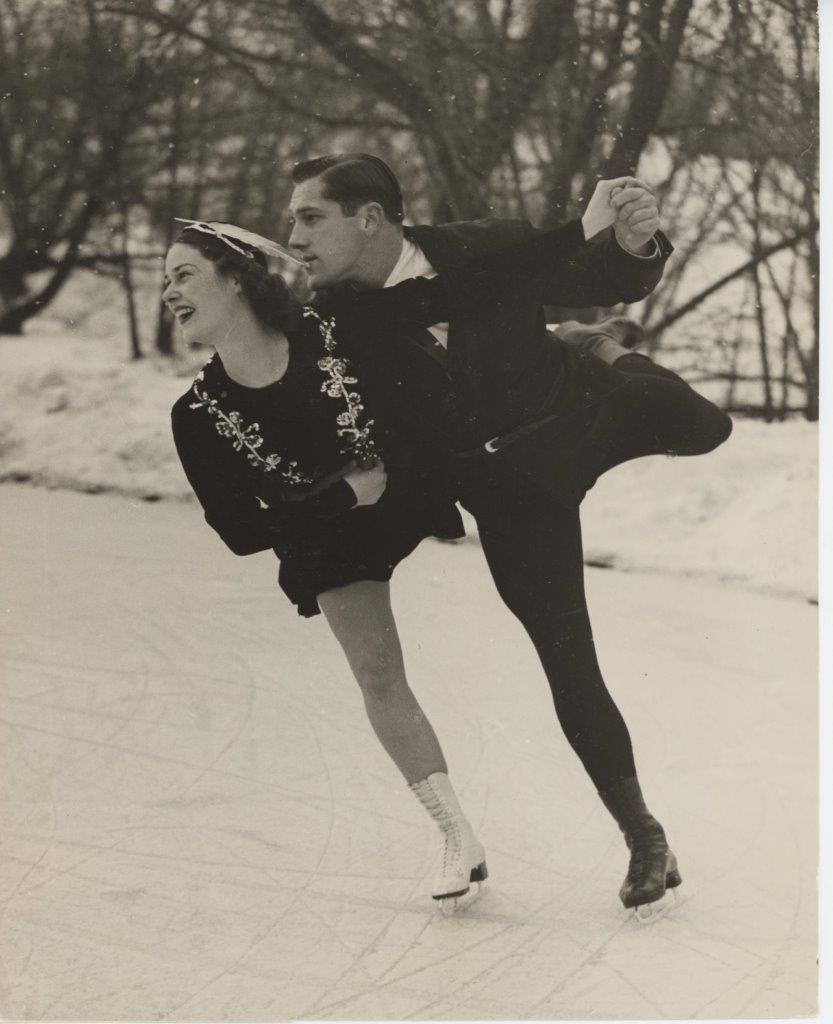
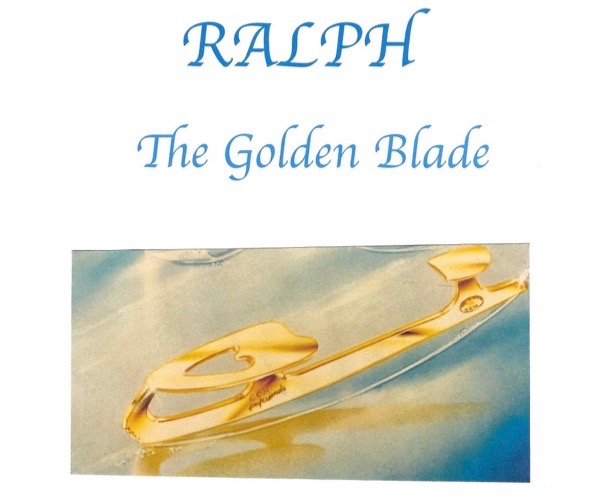
Photo above: Ralph with Eleanor O’Meara at Hoggs Hollow natural rink, Toronto
Part One
There comes a time in every young person’s life when they find themselves at a crossroad, forced to make decisions about which journey to take.
Sometimes it involves giving up what you know, love and trust for an unknown commodity. A choice may be adventurous, but it also may be attached to unknown risks and unsettling circumstance.
This is the dilemma that faced a young lad of Scottish decent named Ralph before he celebrated his twelfth birthday.
The year was 1931 in Toronto, Canada. The Great Depression that had swept across the globe was in its second year, impacting the wealthy of North America particularly hard.
Ralph’s father Bert had been spared the worst of it through his innovation and financial dexterity over the years in the steel, banking and real estate industries. While he was not a wealthy man his family was slightly above the fray.
For those thousands of people swept up into the fray life in the 1930’s was full of loss and devastation.Toronto, as the financial capital of Canada, was drastically effected.
Many of the wealthy old-guard establishment were wiped out financially. Much of what was the middle class could be found lining up for the relief dole and soup kitchens.
Unskilled single men flooded into the city on freight trains looking for work. Most left the same way for the mines in the north or gold in the western mountains, frustrated and discouraged.
Wages fell, stores and factories closed, families slept in their cars, or worse, and three public welfare bureaus tried to keep people from starving or freezing to death.
A healthy diversion from all this calamity was Toronto’s vast sporting scene, both professional and recreational.
All kinds of sport and cultural events were being held in Toronto but the people’s favourite pastime was rooting for, listening to, or if you were lucky, watching one of the three local professional teams.
The baseball Maple Leafs played at their baseball specific, intimate stadium by the lake on Fleet Street.
The football Argonauts bashed heads on the gridiron in front of their fanatics at jam-packed, raucous Varsity Stadium in search of the Grey Cup.
Toronto’s professional hockey team had been known as the St. Pats for many years playing out of the seven-thousand seat Arena Gardens on Mutual Street.
Around 1930 a business-savvy war hero of Irish decent purchased the team, changed its name and colours, and set about building a hockey temple unlike any other in Canada.
His name was Constantine Falkland Cary Smythe, known simply as ‘Conn.’
His vision and actions would be the beginning of the Smythe familyera in Canadian hockey which saw the blue and white clad Maple Leafs win eleven Stanley Cups and become an iconic hockey brand around the world.Conn financed, constructed and finished Maple Leaf Gardens in under a year during these dire financial times. This accomplishment became a thing of legend.
The building opened on November 12th. 1931 with 12,471 patrons watching the Leafs lose 2-1 to the Chicago Blackhawks.
Part Two
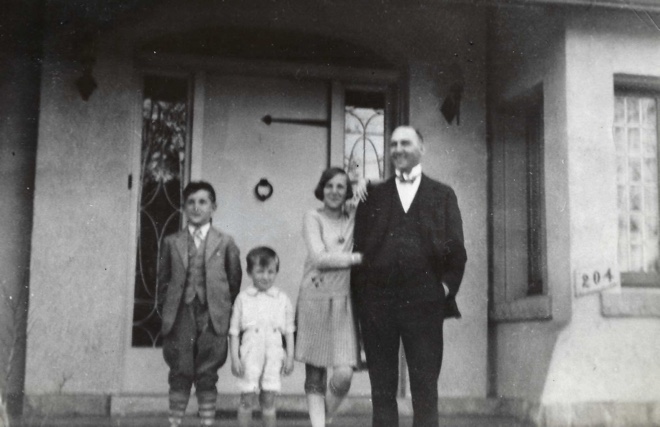
Photo: from left, Ralph, Ross, June and Bert on the porch in Moore Park.
Similarly, a frozen sheet of ice for skating would hold an allure for Ralph and his father Bert. The youngster had grown tall and sturdy after spending every summer on his uncle Angus’ vast farm in Goderich Ontario. This wasalso where Bert was born.
The first of their clan had settled here when they arrived in Canada during the 1830’s and the Goderich area had become the family seat.
One hundred years later even though it’s members had spread out around the province many including Bert and his family would venture home during the summer months for reunions and get togethers.
Angus Scott had prospered at dairy farming and was very fondof young Ralph. Perhaps it had to do with Bert giving the boy his middle name ‘Scott’ out of respect for his enterprising cousin.
He could steer a tractor at age four with Angus working the clutch and gear shift, then by eight his apprentice could drive the vehicle on his own.
As it turned out the long days in the fields squat-lifting bails of hay and mending wooden fences developed Ralph into a striking physical specimen. When he reached ten years the boy was solidly muscled with legs like tree trunks.
These physical attributes manifested themselves well for Ralph in the athletic activities he participated in. He became what people call ‘a natural,’ excelling at baseball, football and hockey.
In this case the apple didn’t fall far from the tree because Bert was an accomplished sportsman himself. It was a given that he would fan the sporting flame in his eldest son.
Ralph was extremely passionate about hockey and because of his past outdoor activities he excelled on the ice.
Organized hockey for juveniles centred mostly around their public schools up to grade eight when pupils would be thirteen years of age. Bert had built a spacious home for his wife Elizabeth and their four children, June, Ralph, Ross and Louise in the Moore Park area of city.
There was a park in the community that every winter provided an outdoor skating rink for pleasure skating and hockey. The Whitney Public School team that Ralph played for would hold its home games here.
In grade five Ralph made the senior team. He was a swift, fluid skater and that year he lead the team in scoring. In his second season he was named team captain.
As the spry laddie approached his teenage years, not only did his physical stature grow, the attention paid to him by the young ladies of Whitney School grew as well. This attraction was something Ralph would have to deal with for many years to come.
On the ice things were going very well too, so well that opposing defenders were sliding in front of Ralph to try and slow down his fleet sojourns into the attacking zone.
Bert and the rest of the family would attend all of Ralph’s games and upon seeing this new method of impeding their skater his dad had a suggestion for the coach.
The father was an excellent athlete in his own right, rugby being Bert’s initial sporting love as a young man. His other leisure activity had been figure skating which he excelled at enough to be an amateur champion several times over.
What he proposed to the coach to solve the ‘sliding’ act was to bring a bench out on the ice and let Ralph practice jumping over it.
That way he could play the puck forward, leap over the opposition, then continue onward with his mission.
Little could it be known at that time that this suggestion would change Ralph’s life forever.
Part Three
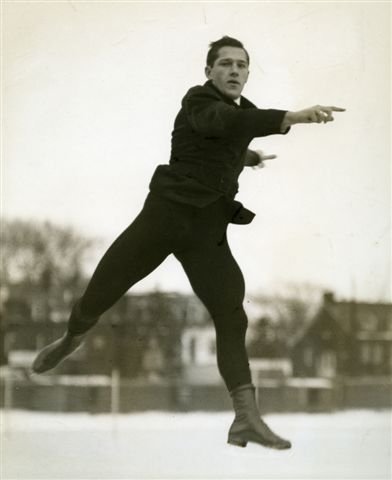
Photo: Ralph at Varsity Stadium perfecting his new skills.
In the spring of 1931 Ralph reached his crossroad.
Because his son took to leaping over benches as a means of eluding attackers something tweaked in Bert’s mind while he watched Ralph soar.
As an amateur skater Bert had joined the Toronto Skating Club, the city’s premier figure skating facility. Situated on Dupont Street in the Annex area of town the building was constructed in 1921. With a state of the art ice surface, viewing gallery and dining room, it was the first of its kind in Canada.
The club soon became a training facility for competitive skaters.
Skilled coaches were hired and over the years members would win medals in Canadian, North America and World championships along with Olympic gold, silver and bronze.
As an added entertainment factor for the public, an annual skating carnival was held in March every year. These events were the highlight of the winter season, and by the late 1930’s the carnival was being held at Maple Leaf Garden to sell out crowds.
Talent came for the United States and Europe to perform in the shows and many would stay on to train, so esteemed had the TSC’s reputation grown.
Bert would take the family to these shows every year and Ralph was captivated by the finessed and grace of the male skaters. He also didn’t mind looking at the somewhat revealing costumes that were showcased by the attractive lady performers.
This exposure to a different kind of skating formed the basis of Ralph’s crossroad conundrum.
Should he give up the game of hockey, a sport he knew, loved and probably had a bright future with, for ‘fancy skating,’ a sport that he might literally fall flat on his face while trying to learn?
Ralph took his chosen path and entered the doors of TSC as a junior student.
The adjustment to skating with ‘pics’ on the front of the skate blade was daunting, but as fate would have it, the man who would mentor Ralph was an inventive figure skating genius.
His name was Gustave Lussi, a Swiss native who had taught in Philadelphia where he developed some of the world’s best skaters.
A stern taskmaster, Lussi was fanatical about his pupils excelling in the rudiments of the sport, that is, compulsory figures.
Basically, this exercise consisted of a skater tracing circular patterns on the ice to demonstrate skill in placing clean turns evenly on round circles.
For a freewheeling ex-puck slinger like Ralph, this could have turned out to be pure torture. However, these elements of the sport were worth sixty percent of a skater’s overall competitive score so there was no choice but to toe the line.
Lussi’s true genius was inventing new methods of spinning and jumping. He studied the physics and aerodynamics of the human body and literally came up with new skating methodologies in his sleep.
He was a brilliant choreographer and innovator introducing recorded music and definitive start and stop times to skaters performances.
All of this expert knowledge was at Ralph’s beck and call and he embraced these studies with all his being.
Camels, flying camels, flying sit spins, flips, combination spins, salcow, lutz, loop and axel were words from a language foreign to the beginner, but over time he mastered them all.
To help his novice, Lussi paired Ralph with an experienced female skater introducing the idea of having them compete as a pair in addition to the solo skating the he would do.
Her name was Bunty Lang and she was sixteen years old to his twelve years.
The most important knowledge that Ralph gained from Bunty was a profound appreciation for the artistic styling and tenacity that ladies brought to the sport. This appreciation would multiply many fold through the years.

Photo: Bunny Lang with Ralph at Toronto Skating Club.
Gustave Lussi had a creed that he insisted all his pupils live up to orthat skater was gone.
It’s major element was dedication to improve, dedication beyond feeling the physical agony, stress and anxiety that are needed to become a champion.
The necessities that ran constant through all his teaching were that every student must have speed, power, discipline, determination, athleticism, musical interpretation, style, elegance, and above all ‘guts.’
Ralph bought into all of the above, and flourished under Lussi’s tutelage.
Unfortunately, their time in together in Toronto was short lived. Lussi departed at the end of the 1932 season to relocate at the Olympic indoor stadium in Lake Placid New York, a facility where he was instrumental in providing ice during the summer months for figure skating.
Part Four
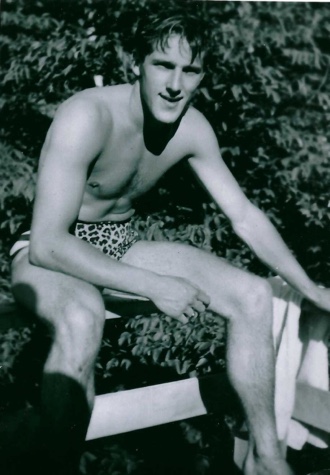
Photo: Ralph at Lake Placid, summer 1935
Luckily, Ralph was able to join Lussi and many of his Canadian skating compatriots in Lake Placid during the summer of 1933, with the blessing of his family.
These were halcyon summer days for the young skaters, away from home and worldly cares. Friendships and romances flourished and they took away lifelong bonds centred around the sport they loved.
Ralph would continue to visit Lussi in New York State every summer until 1940.
His first major competition was the Canadian Junior championships held in Ottawa in 1934. He and Bunty came in a respectable third place for a bronze medal, and Ralph won another bronze in his first junior men’s test.
Bunty retired from skating after that season but Ralph and his new partner, Betty Chalmers, won the junior pairs gold medal the next season. A second place finish in that 1935 junior men’s contest was a notch up for the former hockey player.

Photo: Ralph, waiting to hit the ice
Ralph had won his first gold medal at the age of sixteen.1936 found Ralph moving to the senior level and skating with another new pairs partner, Veronica Clarke. Their chemistry must have been electric because they won the Canadian gold medal for the next three years.
This duo also travelled to Boston and was able to win the North American pairs title in 1937, Ralph’s first international gold medal.
To make things even more interesting, the couple competed together in ice dancing that same year winning the Canadian ‘Tenstep’ gold and the ‘Waltz’ silver medal. 1938 saw them add another gold in the national ‘Fourteen’ step competition.
A change of pairs partners 1940 saw Norah McCarthy join Ralph on the podium to accept a Canadian pairs gold medal.
The next year,1941, Eleanor O’Meara skated into his life long enough to win both our national title and in Philadelphia, the North American pairs gold.
Ralph had moved up to the senior level in men’s as well, earning a bronze medal at Ottawa in 1937, then silvers in 1938 and 1939.
The men’s gold medal was placed around his neck for the first time in the nation’s capital in 1940, then again at the Montreal test in 1941.
One competition that faded away with time was the ‘Fours,’ where two couples skated together.Ralph competed with three of his TSC senior club-mates to come second at the Canadian championships on his first attempt in 1936.
That meant he had won three medals in his first year of competition.
Then in 1938, skating with Veronica and another couple, the national gold was theirs.
The North American championship in Fours would be captured on native soil in 1939 skating with the two Caley sisters and the legendary Montgomery Wilson.
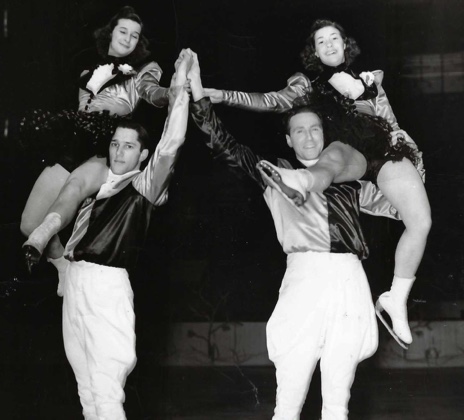
Photo: North American Champion Fours with the Caley sisters and Montgomery Wilson 1939.
The highlight of Ralph’s figure skating career was winning the men’s North American gold medal title in Philadelphia during the 1941 championships.
With this victory Ralph held twelve Canadian and four North American titles in four different disciplines. These accomplishments prompted a sports journalist to proclaim him Canada’s ‘Golden Blade.’
His sights had been set on the Tokyo Olympics in 1940, but due to international politics and the Second World War there were no winterOlympic games between 1936 and1948.
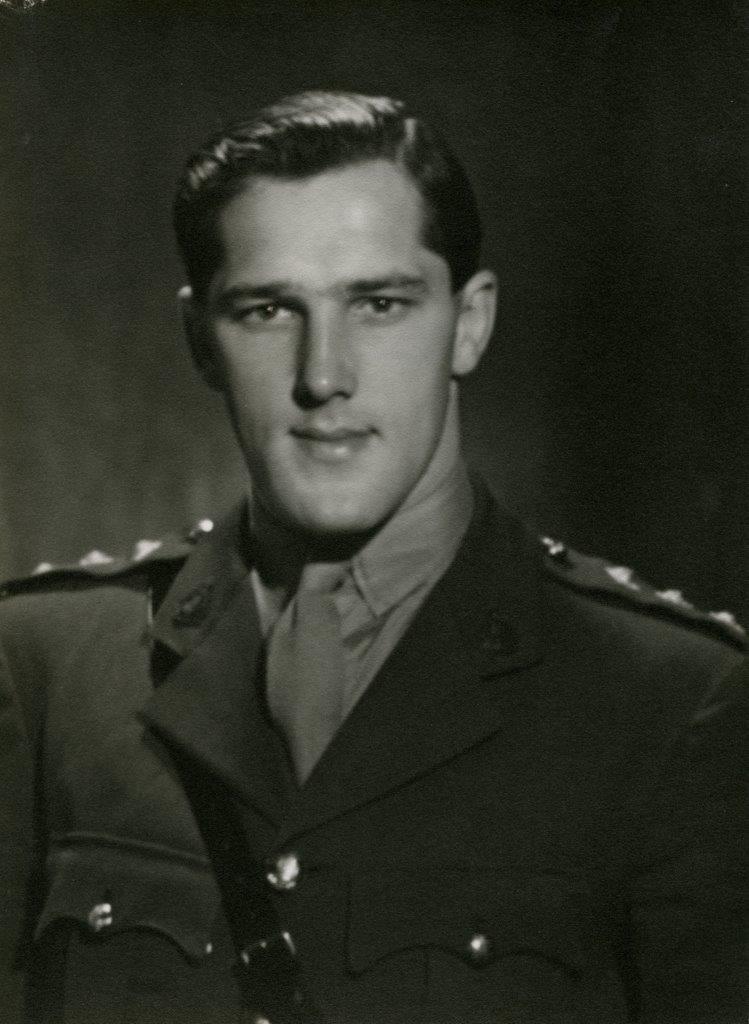
Photo: Major Ralph McCreath
After serving four years with Canadian army in North Africa and Europe, Ralph came home and won the 1946 Canadian men’s title. This would be his thirteenth Canadian medal and final competition.
Gustave Lussi would be proud of the man Ralph had become on and off the ice.
Ralph Scott McCreath was inducted into the Canadian Figure Skating Hall of Fame in 1994.
History confirms that he did choose the correct journey at that crossroad.
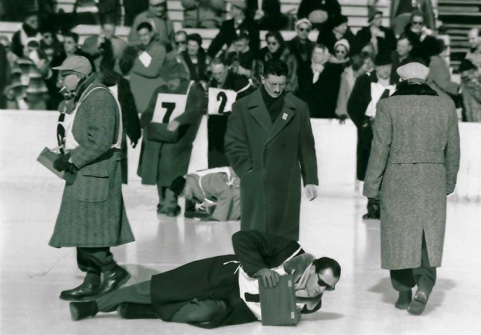
Photo: Ralph on the ice as an Olympic Figure Skating Judge, Cortina Italy, 1956.
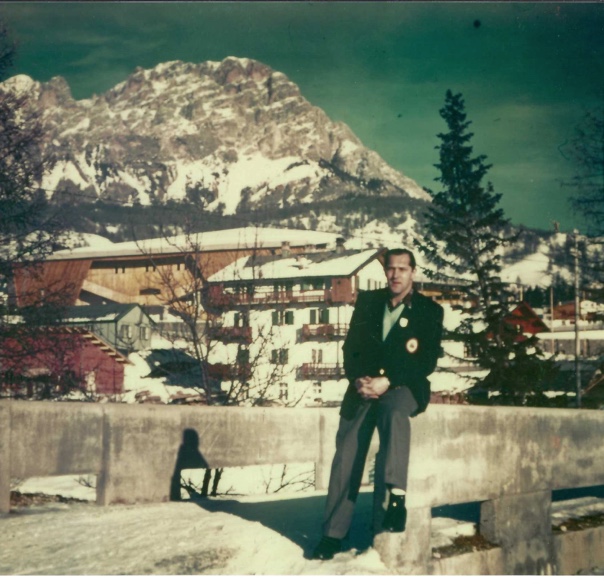
Photo: Ralph in his Olympic jacket Cortina Italy, 1956.

Photo: Ralph drive close friend 1948 Olympic gold medalist Barbara Ann Scott at her victory parade, Ottawa 1948.
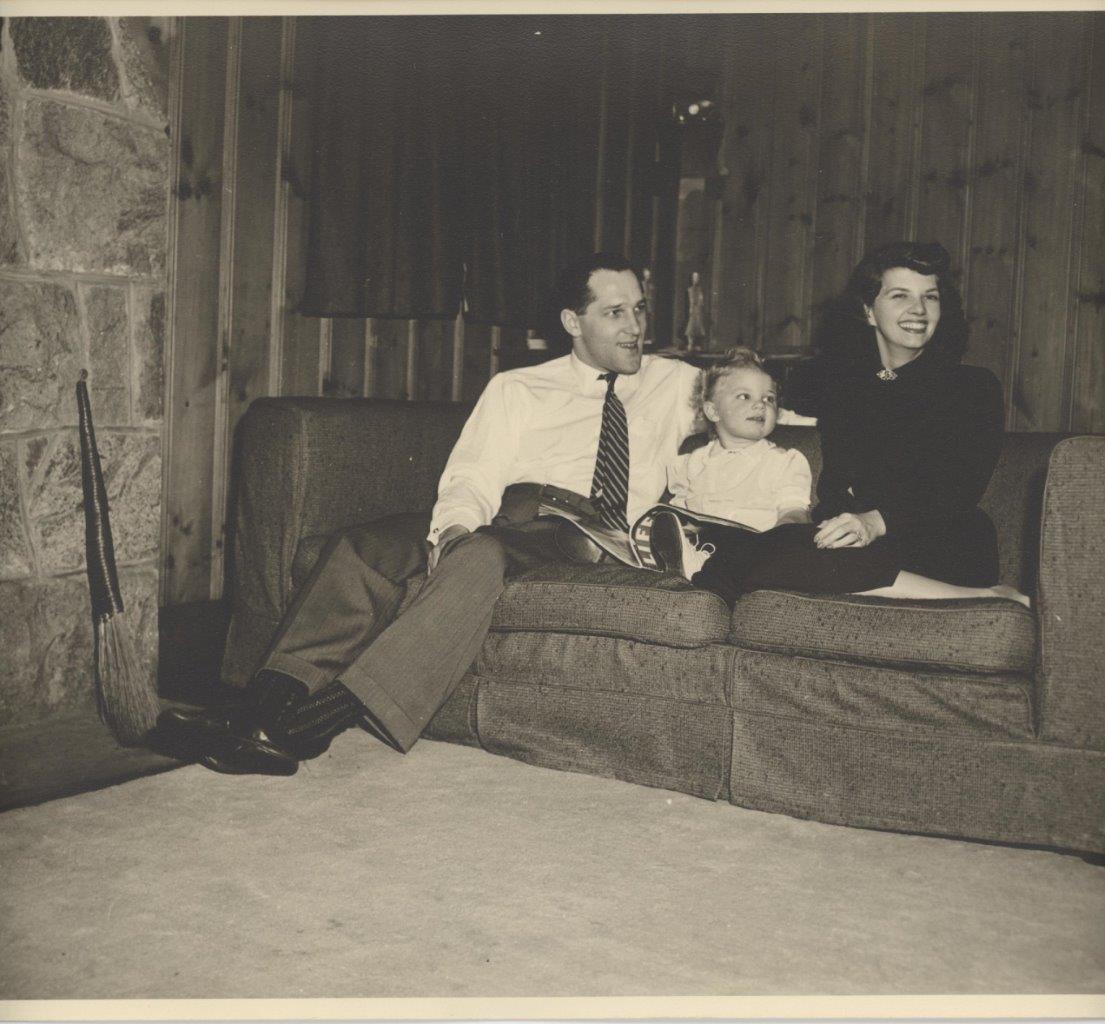
Photo: Ralph, yours truly, and wife Myrtle at home in Toronto 1950.

